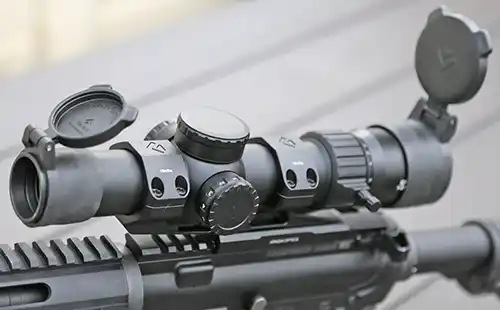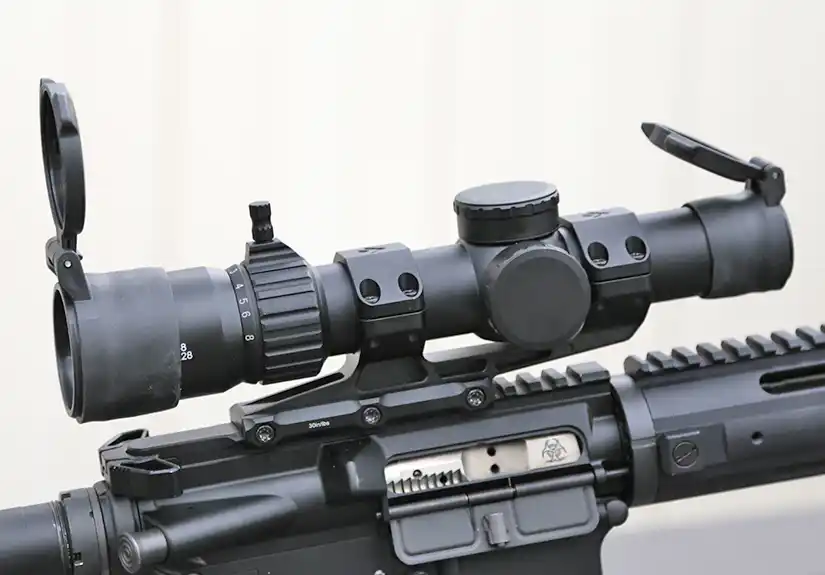As much as I like basic reflex sights and high magnification scopes, the Arken EP-8 1-8×28 LPVO FFP Illuminated KLBOX (also referred to as the Arken EP8) turned out to be a great option for my rifle. It’s useful for close quarters, with enough magnification to make solid hits at a distance. You’ll need some time to get used to the KLBOX reticle, but the optic itself is easy to use immediately. If you’re looking for an optic for your AR platform that offers versatility without breaking the bank, read on.
Arken EP-8 1-8×28 LPVO FFP Illuminated KLBOX specs
Most of the specifications can be found right in the name. Arken’s $499.99 EP-8 is a low-power, variable optic with a 1-8x magnification range. The design features a 28mm objective housed in a 34mm tube. Eye relief is a generous 3.74″, which is plenty for a 5.56 rifle. Field of view goes from 121.15′, or 22 degrees, at 1x, down to 14.56′, or 2.78 degrees, at 8x. Elevation and windage both offer 110 MOA of adjustment in 1/4 MOA increments. The first focal plane reticle is a BDC-style “KL BOX”, which can be pretty useful with a bit of practice. A single CR2032 battery powers its illumination.

Best price on the Arken EP8 I could find is at MidwayUSA
There’s an integrated and removable throw lever, and large-diameter, low-profile turrets. Overall length is 10.31 inches, and it weighs 21 ounces without a mount. Arken includes Flip-Its (lens covers), though they may ship separately..
Installation of the Arken EP-8 1-8×28 LPVO
For mounting, I opted to go with the Arken Rigid Precision Mount. These $69.99 mounts are available in either zero or 20 MOA configurations, for 30mm and 34mm tubes. I chose the zero MOA, as it’s more suited to my needs. With that installed on my upper, I torqued it to the recommended 30 in/lbs. From there, I mounted the Arken EP-8, leveled it, and torqued the rings to 18 in/lbs.
Arken engraves the torque specs discreetly right on their mount, no need to go looking up specs online. After using a laser to roughly zero it in at 50 yards once it was mounted, I was ready to go. I say “roughly”, because I installed it on my AR22 first. I wanted to try out that reticle and magnification range with cheap ammo first.

First range trip
As mentioned, I originally mounted the Arken EP-8 on my AR22. This allowed me to check out the glass and get some time with the reticle before committing to testing with 5.56 ammo. The first thing I noticed was that the image was nice and sharp. The quality is expected, particularly given Arken’s emphasis on Japanese glass. But this is an optic that carries an MSRP of $499.99, and I regularly use camera lenses costing 2-4x as much. So when I get behind cheap glass, it’s noticeable. None of that here, even at 8x. While I could detect some color fringing under difficult lighting, it’s perfectly fine for the intended purpose.
The zoom lever starts at the 3 o’clock position for 1x, and ends up around 9 o’clock at 8x. The optic offers smooth and well-damped adjustments, avoiding excessive stiffness. However, the KL BOX reticle can be difficult to see in some lighting without illumination. But there’s that big circle around it, which should be sufficient for close work. Cranking up the magnification brings that reticle into view better. Of course, some understanding of the reticle is in order if you want to get the most out of it. So the initial trip with rimfire turned out to be very useful.
The Arken EP8 KL BOX reticle
A lot is going on with this reticle. It’s a combination of BDC (Bullet Drop Compensator) and ranging ladder: It features a central aiming horseshoe with holdover dots for close-range engagement. Below that, a range estimation ladder assists in calculating target distance. By framing the target’s torso within the appropriate KL (Known Length) box on the ladder, it’s possible to estimate the distance to the target. This is based on known body dimensions (shoulder width, torso height). From there, the shooter engages using the designated aiming point within the box.
All this works due to the reticle being in the First Focal Plane (FFP). It maintains the same size relative to the target at all magnification levels. Which allows for accurate holdovers and ranging across the zoom range.

Advantages are obvious once the functions of the reticle are understood. This system can offer a quick and intuitive way to estimate target distance without complex calculations. It provides multiple aiming points for various distances and wind conditions. In turn, this can enhance shot accuracy. Adaptability is another advantage, as the reticle works well for close-quarters and longer-range engagements within the scope’s magnification capabilities. With practice, the simplicity of the design makes it easy to use, even for those with less experience with ranging and holdovers. If there is a downside, it’s the first magnified optic I’ve used where the illumination was needed more often than not. Dialing in the brightness was quickly accomplished with the dial on the side.

The turrets
While I like the huge engraved turrets of the Arken EP-5, I have mixed feelings about the ones on the EP-8. The turrets themselves are large, but very low profile. As they should be. Yet the smaller numbers can be difficult to read. Despite that, the turrets themselves have positive, tactile clicks. So they’re good if you’re just dialing in a few clicks and don’t have to see the numbers. And I suppose that’s probably for the best, because you don’t even need to look at them to make small corrections. On the bright side, once dialed in, I didn’t see any need to change them.
While I didn’t do a box test, I made some large adjustments to check tracking, and they tracked well. I’m not even sure that test is valid these days, as I have yet to find a decent optic fail.

Best price on the Arken EP8 I could find is at MidwayUSA
Second range trip
With a bit of time using the reticle under my belt, I mounted the Arken EP-8 on my AR, and headed back out to the range. This time, I took advantage of some of the garbage other shooters had left behind. My first target’s “torso” was an old water heater. Topped with a shot-up pumpkin, we had a pretty good approximation of a “bad guy”.
Sadly, we didn’t have multiple targets like this, and we were very limited in the distances we could shoot, with 200 yards being the max. We used a cardboard box marked off approximately 19″x28″ (the shoulder and torso values) and hiked up a hill to set it up. This allowed us to get a feel for the ranging. So while we could use the reticle to determine distances, in practice, we didn’t get to engage multiple targets across great distances. If someone wants to provide us with some AR500 steel torsos, reviews like this would be a lot more fun.

Conclusion
This was an interesting experience for me. I primarily used irons or a 1x reflex sight during my time with an AR. I’ve used a scope as well, but that was while shooting prone. And the last LPVO I had didn’t get taken out too often. Yet I found myself engaging targets across a few hundred yards, with a variable optic and a completely new reticle for me. And it was fun.
For my recreational shooting, the KL BOX reticle may not be ideal. But if I was using my rifle for more defensive-style engagements, I can absolutely see the value in it. Overall the Arken EP-8 has turned out to be a solid performer at a reasonable price. You can check it out yourself at arkenopticsusa.com.

As always, I’d like to thank Arken Optics for providing their Arken EP-8 1-8×28 LPVO FFP Illuminated KLBOX for my testing and evaluation. And I hope my readers have found this review informative.
